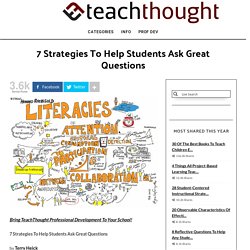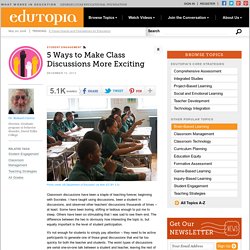

Protocols « School Reform Initiative. Competing Facts Are a Fact of Life. Image by David Mulder, creative commons "Alternative facts" have gotten quite a bad rap lately, which — while understandable — is a shame.

Because virtually any argument worthy of the name involves competing sets of facts. That's why it's an argument, not a hug-fest. 7 Strategies To Help Students Ask Great Questions - TeachThought PD. Bring TeachThought Professional Development To Your School!

7 Strategies To Help Students Ask Great Questions by Terry Heick Questions can be extraordinary learning tools. A good question can open minds, shift paradigms, and force the uncomfortable but transformational cognitive dissonance that can help create thinkers. In education, we tend to value a student’s ability to answer our questions. Talking Across Divides: 10 Ways to Encourage Civil Classroom Conversation On Difficult Issues. During the week of Oct. 3 to 7, we are posting a new Student Opinion question each day about five issues that are dividing Americans this election year.

Those posts will remain open to comment until Election Day, and we invite teenagers from anywhere in the world to share their thoughts and reply to the thoughts of others. The challenge? We are asking them to consciously counter the tone and content of much of what is online around hot-button issues and, instead, model respectful dialogue that fosters understanding of other points of view. Better Student Questions Snyder. Nine Ways to Improve Class Discussions. I once heard class discussions described as “transient instructional events.”

They pass through the class, the course, and the educational experiences of students with few lingering effects. Ideas are batted around, often with forced participation; students don’t take notes; and then the discussion ends—it runs out of steam or the class runs out of time. If asked a few days later about the exchange, most students would be hard-pressed to remember anything beyond what they themselves might have said, if that. So this post offers some simple suggestions for increasing the impact of the discussions that occur in our courses.
5 Ways to Make Class Discussions More Exciting. Classroom discussions have been a staple of teaching forever, beginning with Socrates.

I have taught using discussions, been a student in discussions, and observed other teachers' discussions thousands of times -- at least. Understanding by Design Part 2: Designing the Essential Questions - Learning Bird. Value and benefits of questions Since Socrates, asking questions has been a hallmark of the teaching profession.

Whether used to guide students through a lecture or to check for understanding on exams, questions are the primary mode of encouraging information transfer from instructor to student and from topic to topic. According to Leven and Long in 1912, teachers spent nearly 80% of the day asking questions; this result has been repeated multiple times since, with similar results. 7 Strategies To Help Students Ask Great Questions. Teaching with Technology Collaboratory - Improving the Use of Discussion Boards. Considerable research indicates that the effective use of discussion boards results in...

Collison, G., Elbaum, B., Haavind, S., & Tinker, R. (2000). Final word. The Marshall Memo Admin - Issues. 1.

How to avoid some common problems in group decision-making 2. Using Socratic seminars in a high-school English class 3. Orchestrating authentic classroom conversations. The Marshall Memo Admin - Issues. The Marshall Memo Admin - Issues. Assessment For Learning Toolkit. Pose Pause Pounce Bounce by @TeacherToolkit #PPPB. Targeted Questioning by @TeacherToolkit. 8 ways teachers can talk less and get kids talking more. If you do fewer teacher-directed activities, that means the kids will naturally do more talking, doesn’t it?

Not necessarily. I have often found myself talking almost constantly during group work and student-directed projects because I’m trying to push kids’ thinking, provide feedback, and help them stay on task. The 7 Fundamental Conditions of Learning - Advice. By Rob Jenkins Last month I wrote about the attributes of the very best teachers, with the goal of identifying for young faculty members, in particular, the qualities they ought to emulate and cultivate.

Several readers complained that my focus was too much on the teacher and not enough on students. Fair enough. This month I’ll try to answer two questions: What do students need in order to learn? And how can we as teachers provide those things? Tips for Effective Dialogue: Dialogue vs. Discussion - The Henderson Group. Interactive communication or dialogue refers to interacting in ways that build shared meaning, rather than colliding in ways that foster disagreement, frustration and confusion. To Teach Facts, Start With Feelings.
Recently, we heard from a teacher who decided to create a more dynamic approach to his history class . . . by teaching it backward, starting with the present day. "Here's the world around you and how it feels to live in it. What happened over the last 20 years to get where we are? What happened in the decade before that? " Unsurprisingly, he met resistance from parents, who thought his approach was crazy. From a neurological perspective, though, starting a history class from the present makes perfect sense. Drawing Out the Story. Slowing Down to Learn: Mindful Pauses That Can Help Student Engagement. The excerpt below is from the book “Mindfulness for Teachers: Simple Skills for Peace and Productivity in the Classroom,” by Patricia A. Jennings. This section is from the chapter entitled “Orchestrating Classroom Dynamics.”
A Handy Chart Featuring 8 Ways to Do Formative Assessment. 26 Keys to Student Engagement. Kids Speak Out on Student Engagement. A space: at the table. Banque d'images ou photolangage @ François MULLER - François MULLER - Picasa Albums Web. Www.nps.gov/nero/greatplaces/dialoguetechniques.pdf. Www.nps.gov/nero/greatplaces/dialogueassumptions.pdf. Www.nps.gov/nero/greatplaces/dialoguearcof.pdf.